2020 SMS Marketing Report
SimpleTexting surveyed hundreds of U.S. consumers, business owners, and marketers to find their preferences and motivations for texting and text marketing.
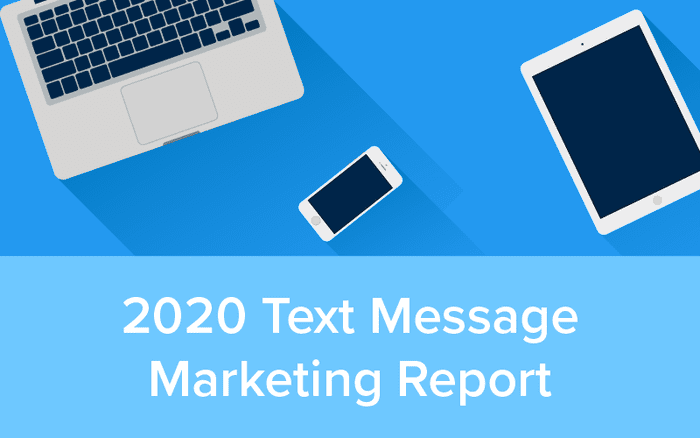
SimpleTexting surveyed hundreds of U.S. consumers, business owners, and marketers to find their preferences and motivations for texting and text marketing.

👋 Hey there! Our 2024 SMS Marketing Survey results are in! Read the report for the most up-to-date insights on text message marketing.
The way that businesses communicate with customers is changing. A decade ago no one expected they’d connect with businesses over Facebook Messenger or that chatbots would be deployed everywhere.
Despite the fluid communication landscape, one thing that has remained remarkably stable over time is the use of SMS as a communication tool. No one thinks twice about receiving or sending a text.
While it may not be as ubiquitous as email marketing, texting has consistently provided itself to be a valuable communication channel. As its popularity continues to rise, we wanted to better understand how businesses and consumers across the U.S. view texting.
For this SMS marketing report, we surveyed hundreds of U.S. consumers, business owners, and marketers to determine their preferences and primary motivations pertaining to texting and text message marketing for business.
Our text marketing research reveals key findings on messaging preferences by:
Read on to capture the full results of the SMS marketing report.
Consumers check their texts early and often.
Our survey found that 42% of Millennials check their text messages 10 or more times per day on average. When asked, ‘how quick are you to check your text notifications throughout the day,’ almost 60% of all consumers surveyed answered within 1-5 minutes of the text coming through.
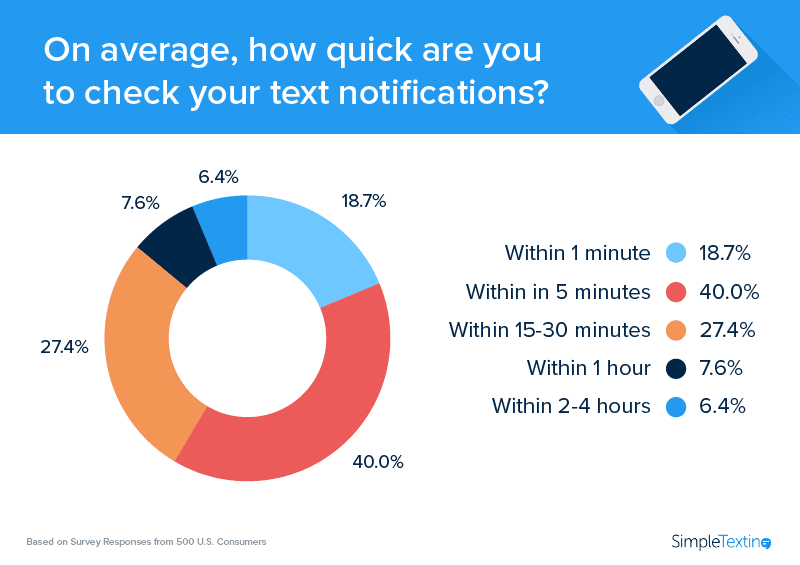
On an average day, consumers check their text messages more than any other app on their phones.
68% of respondents say that checking, sending, and answering text messages is the activity that they’re most engaged with on their phones throughout the day, followed by:
The informality and time-efficiency of texting, in comparison to email or phone calls, naturally makes it an activity that consumers interact with most. Therefore, developing texting business communication strategies around this channel can be highly effective.
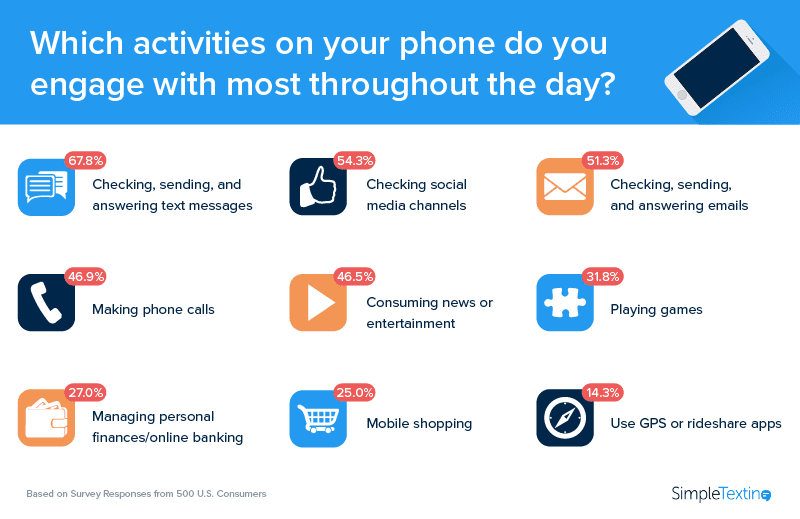
The majority of respondents are open to receiving texts from businesses about:

The majority of respondents (60.8%) would like the capability to text businesses back about customer support issues such as product/service questions, installation, troubleshooting, product defects, and returns. Overall, customers would rather actively text businesses back about customer support issues, and passively receive texts from businesses about shipping, order confirmations, alerts, and important reminders.
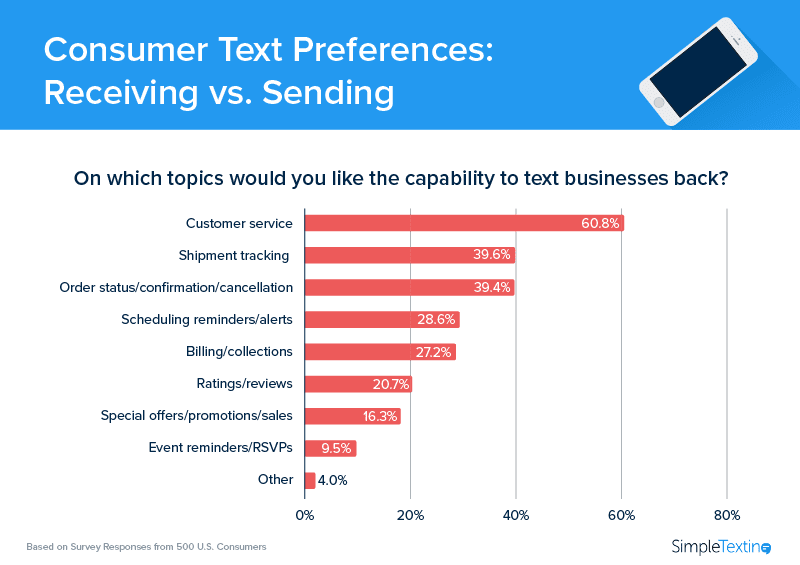
Consumers like having the capability to text businesses back.
The majority of respondents (over 45%) value two-way conversations, and think having the capability to text businesses back is useful, including 43% of Gen X respondents. 12.9% even said they’re more likely to support businesses that offer text-back capabilities.
Consumers value mobile messaging support because it’s both responsive and convenient. Where emails and phone calls can have larger-than-life lead times, texting lets consumers easily get in touch with businesses quickly and efficiently. What’s more, a business’s customer support personnel will save time, as texting eats up less time than a customer service call would.
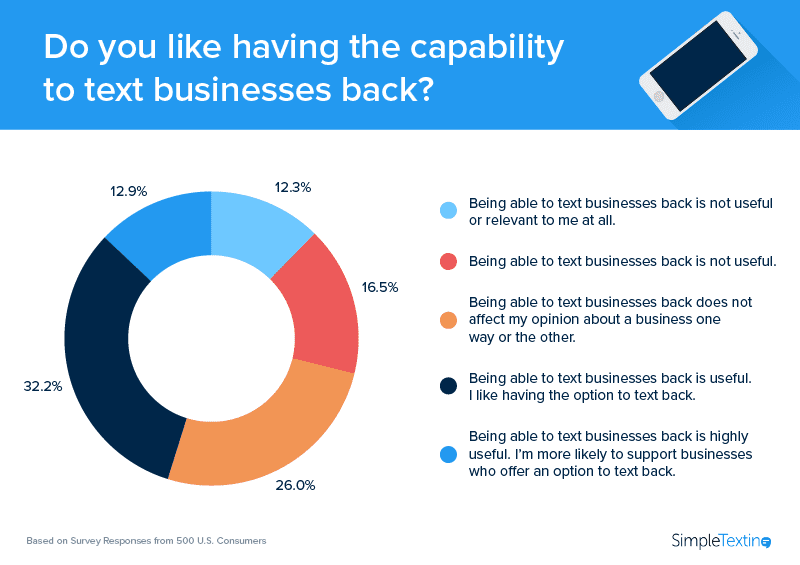
Consumers prefer texts from businesses when it comes to time-sensitive promotions.
50% of respondents said that flash sales and time-sensitive promotions would encourage them to opt into a business’s text messages, followed by back-in-stock notifications, customer support, and event reminders for things like:
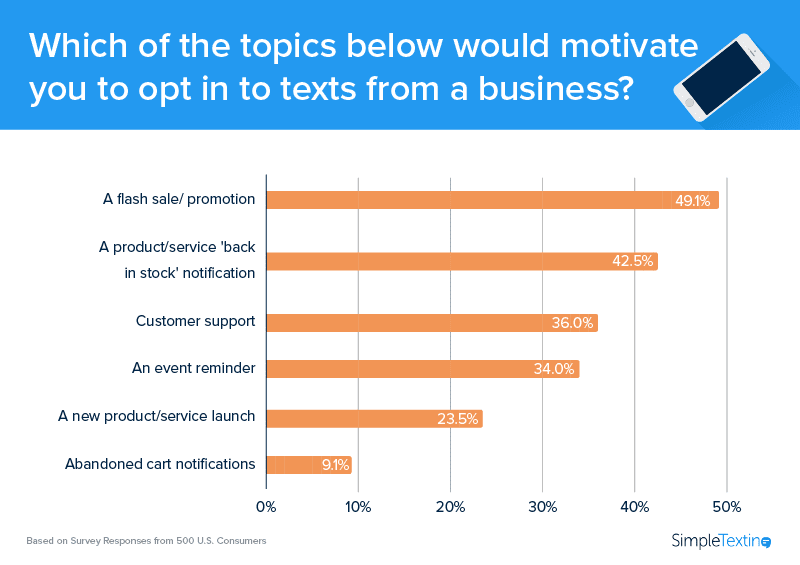
Consumers are more likely to subscribe to texts from e-commerce and retail businesses.
46% of respondents are more likely to opt into text messages from the e-commerce/retail industry, followed by 43% from healthcare, 41% from banking and finance, and 33% from the travel industry.
E-commerce and retail work symbiotically with texting for product launches, order notifications, shipment tracking, sales/promotions and post-purchase reviews. E-commerce businesses see 98% open rates and 36% click-through rates, because consumers enjoy when good deals come to them directly through text, rather than sifting through websites, emails, and social media for the best sales.
At the same time, consumers are likely to subscribe to text messages from hospitals, doctor’s offices, or medical clinics for helpful reminders related to appointments, prescriptions, test results, bills, and patient satisfaction surveys. The focus of healthcare staff can then shift from administrative tasks to patient care.

With opt-in rates rising, businesses are increasing their SMS marketing budgets.
61% of businesses and marketers surveyed are increasing their text marketing budgets in 2020, and 41% have seen an increase in their consumer opt-in rates over the past year. Businesses are seeing the tangible benefits of text marketing in terms of their return on investment, sales conversions, and higher open and click-through rates in comparison to other messaging channels.
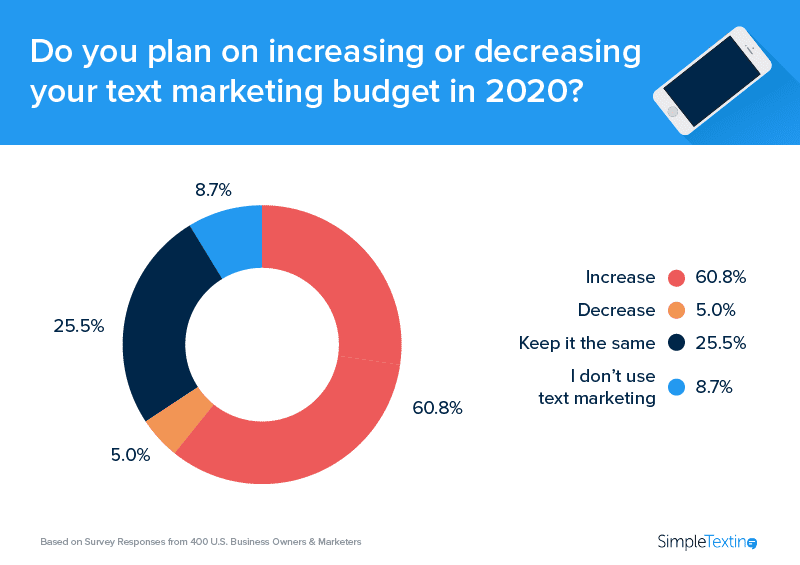
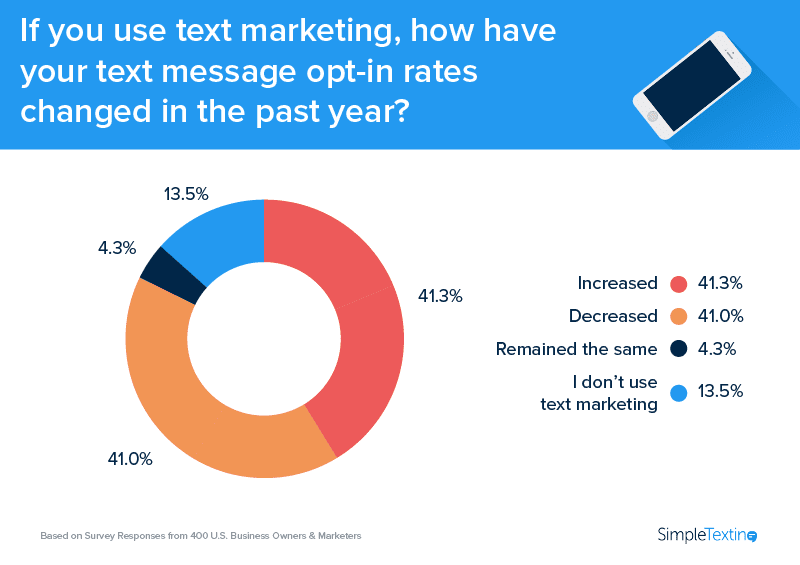
Businesses are texting their customer bases for faster delivery of messages and strengthened customer engagement.
Over 62% of business owners and marketers surveyed believe that fast delivery of messages is the biggest benefit of texting their audience, followed by strengthened customer engagement and cost-effectiveness. Text messaging for businesses ensures messages are seen by consumers as quickly as possible. Additionally, text marketing is actually quite cost-effective in comparison to other forms of digital marketing and advertising.
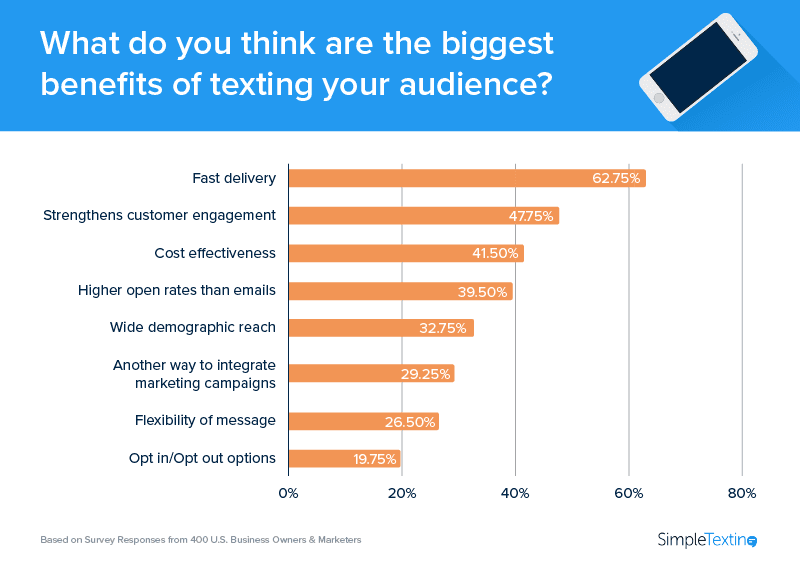
Businesses are investing in SMS for business because of large mobile audiences, real-time reach, and high open rates.
Over 52% of businesses and marketers listed a large mobile audience as their primary motivator for investing in text marketing, followed by strengthened customer engagement, real time reach, and high open rates.
Large mobile audience refers to the benefit of reaching virtually anyone with a cellphone, but it also refers to the benefit of texting in bulk and the capability of reaching large groups of people at one time. Strengthened customer engagement is another motivator for investing in text messaging for business as communication flows and information exchanges are timely.
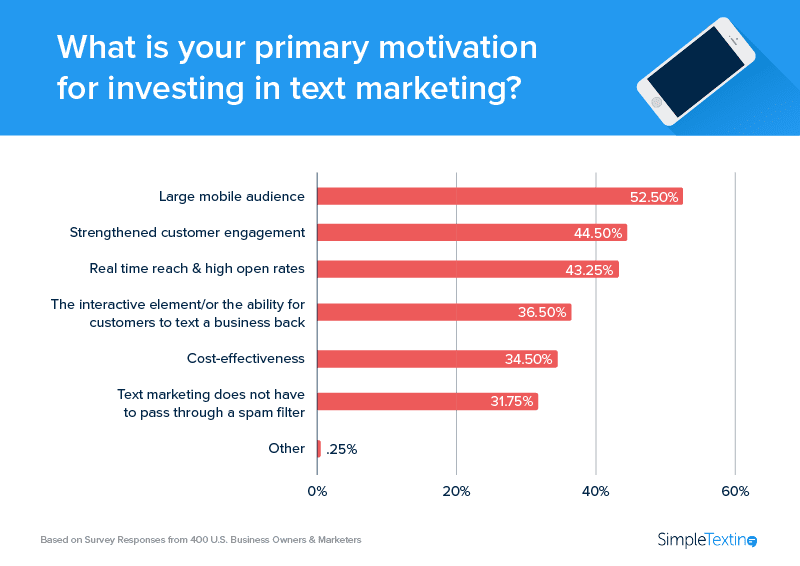
Text message click-through rates are much higher than email click-through rates.
The majority of businesses reported that their text marketing click-through rates were between 20% and 35%, whereas the majority of business owners reported that their email marketing click-through rates were between 10% and 20%.
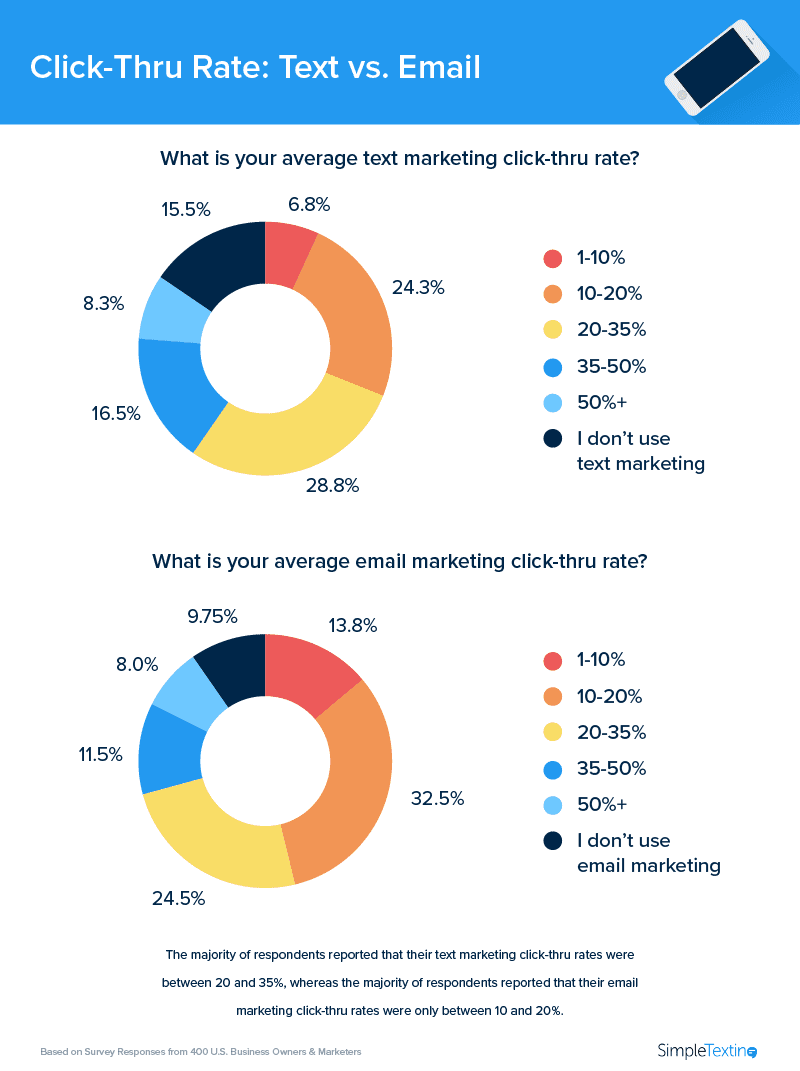
All in all, our text marketing research reveals the future of text messaging is bright for businesses. 66% of consumers either prefer mobile messaging or consider it their second choice for communications when compared to phone and email. Click-through rates for text marketing are higher than any other messaging channel, and with more businesses leveraging SMS software platforms and developing text-enabled phone lines, an infrastructure will be set in place to prioritize communicating with customers seamlessly with mobile.
Visit our success stories to see how text messaging for businesses within e-commerce, retail, education, healthcare, real estate, & technology have leveraged the SimpleTexting SMS platform to grow their sales pipelines and beef up their overall marketing strategies.
Drew Wilkinson is the Head of Marketing at SimpleTexting. Drew has more than a decade of experience managing successful integrated marketing programs to build brands, raise awareness, and generate demand.
More Posts from Drew WilkinsonOn September 1, 2025, a new Texas regulation takes effect that changes the way companies can send text messages to consumers in the state. Here’s what you need to know.
ReadClick-to-message for AdWords and Google My Buisness is an easy, effective way to step up your SMS marketing efforts. Here's how to get it set up.
ReadStart a text marketing campaign or have a 1-on-1 conversation today. It's risk free. Sign up for a free 14-day trial today to see SimpleTexting in action.
No credit card required